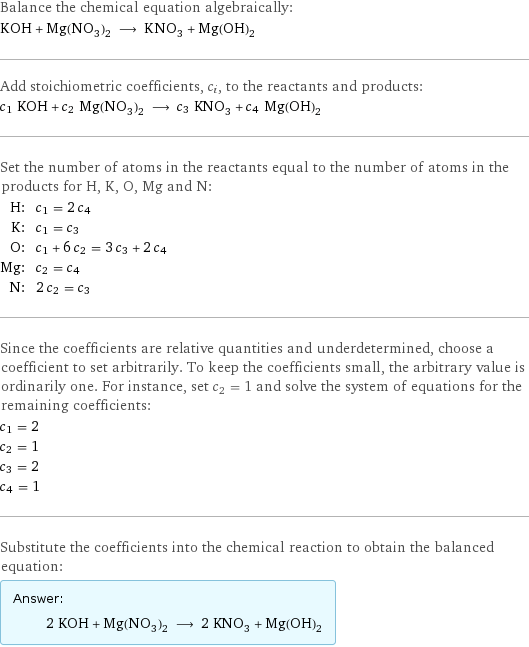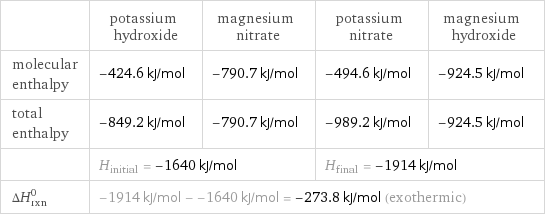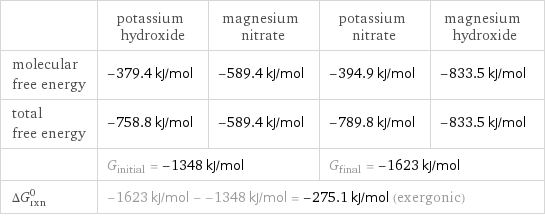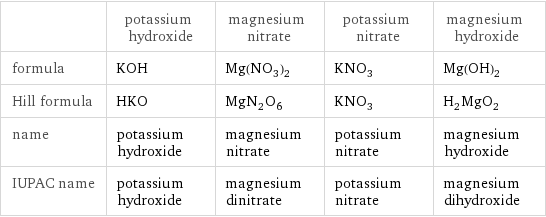Input interpretation

KOH potassium hydroxide + Mg(NO_3)_2 magnesium nitrate ⟶ KNO_3 potassium nitrate + Mg(OH)_2 magnesium hydroxide
Balanced equation

Balance the chemical equation algebraically: KOH + Mg(NO_3)_2 ⟶ KNO_3 + Mg(OH)_2 Add stoichiometric coefficients, c_i, to the reactants and products: c_1 KOH + c_2 Mg(NO_3)_2 ⟶ c_3 KNO_3 + c_4 Mg(OH)_2 Set the number of atoms in the reactants equal to the number of atoms in the products for H, K, O, Mg and N: H: | c_1 = 2 c_4 K: | c_1 = c_3 O: | c_1 + 6 c_2 = 3 c_3 + 2 c_4 Mg: | c_2 = c_4 N: | 2 c_2 = c_3 Since the coefficients are relative quantities and underdetermined, choose a coefficient to set arbitrarily. To keep the coefficients small, the arbitrary value is ordinarily one. For instance, set c_2 = 1 and solve the system of equations for the remaining coefficients: c_1 = 2 c_2 = 1 c_3 = 2 c_4 = 1 Substitute the coefficients into the chemical reaction to obtain the balanced equation: Answer: | | 2 KOH + Mg(NO_3)_2 ⟶ 2 KNO_3 + Mg(OH)_2
Structures

+ ⟶ +
Names

potassium hydroxide + magnesium nitrate ⟶ potassium nitrate + magnesium hydroxide
Reaction thermodynamics
Enthalpy

| potassium hydroxide | magnesium nitrate | potassium nitrate | magnesium hydroxide molecular enthalpy | -424.6 kJ/mol | -790.7 kJ/mol | -494.6 kJ/mol | -924.5 kJ/mol total enthalpy | -849.2 kJ/mol | -790.7 kJ/mol | -989.2 kJ/mol | -924.5 kJ/mol | H_initial = -1640 kJ/mol | | H_final = -1914 kJ/mol | ΔH_rxn^0 | -1914 kJ/mol - -1640 kJ/mol = -273.8 kJ/mol (exothermic) | | |
Gibbs free energy

| potassium hydroxide | magnesium nitrate | potassium nitrate | magnesium hydroxide molecular free energy | -379.4 kJ/mol | -589.4 kJ/mol | -394.9 kJ/mol | -833.5 kJ/mol total free energy | -758.8 kJ/mol | -589.4 kJ/mol | -789.8 kJ/mol | -833.5 kJ/mol | G_initial = -1348 kJ/mol | | G_final = -1623 kJ/mol | ΔG_rxn^0 | -1623 kJ/mol - -1348 kJ/mol = -275.1 kJ/mol (exergonic) | | |
Equilibrium constant
![Construct the equilibrium constant, K, expression for: KOH + Mg(NO_3)_2 ⟶ KNO_3 + Mg(OH)_2 Plan: • Balance the chemical equation. • Determine the stoichiometric numbers. • Assemble the activity expression for each chemical species. • Use the activity expressions to build the equilibrium constant expression. Write the balanced chemical equation: 2 KOH + Mg(NO_3)_2 ⟶ 2 KNO_3 + Mg(OH)_2 Assign stoichiometric numbers, ν_i, using the stoichiometric coefficients, c_i, from the balanced chemical equation in the following manner: ν_i = -c_i for reactants and ν_i = c_i for products: chemical species | c_i | ν_i KOH | 2 | -2 Mg(NO_3)_2 | 1 | -1 KNO_3 | 2 | 2 Mg(OH)_2 | 1 | 1 Assemble the activity expressions accounting for the state of matter and ν_i: chemical species | c_i | ν_i | activity expression KOH | 2 | -2 | ([KOH])^(-2) Mg(NO_3)_2 | 1 | -1 | ([Mg(NO3)2])^(-1) KNO_3 | 2 | 2 | ([KNO3])^2 Mg(OH)_2 | 1 | 1 | [Mg(OH)2] The equilibrium constant symbol in the concentration basis is: K_c Mulitply the activity expressions to arrive at the K_c expression: Answer: | | K_c = ([KOH])^(-2) ([Mg(NO3)2])^(-1) ([KNO3])^2 [Mg(OH)2] = (([KNO3])^2 [Mg(OH)2])/(([KOH])^2 [Mg(NO3)2])](../image_source/a00bcc54c600ed187fed13daa98c74ef.png)
Construct the equilibrium constant, K, expression for: KOH + Mg(NO_3)_2 ⟶ KNO_3 + Mg(OH)_2 Plan: • Balance the chemical equation. • Determine the stoichiometric numbers. • Assemble the activity expression for each chemical species. • Use the activity expressions to build the equilibrium constant expression. Write the balanced chemical equation: 2 KOH + Mg(NO_3)_2 ⟶ 2 KNO_3 + Mg(OH)_2 Assign stoichiometric numbers, ν_i, using the stoichiometric coefficients, c_i, from the balanced chemical equation in the following manner: ν_i = -c_i for reactants and ν_i = c_i for products: chemical species | c_i | ν_i KOH | 2 | -2 Mg(NO_3)_2 | 1 | -1 KNO_3 | 2 | 2 Mg(OH)_2 | 1 | 1 Assemble the activity expressions accounting for the state of matter and ν_i: chemical species | c_i | ν_i | activity expression KOH | 2 | -2 | ([KOH])^(-2) Mg(NO_3)_2 | 1 | -1 | ([Mg(NO3)2])^(-1) KNO_3 | 2 | 2 | ([KNO3])^2 Mg(OH)_2 | 1 | 1 | [Mg(OH)2] The equilibrium constant symbol in the concentration basis is: K_c Mulitply the activity expressions to arrive at the K_c expression: Answer: | | K_c = ([KOH])^(-2) ([Mg(NO3)2])^(-1) ([KNO3])^2 [Mg(OH)2] = (([KNO3])^2 [Mg(OH)2])/(([KOH])^2 [Mg(NO3)2])
Rate of reaction
![Construct the rate of reaction expression for: KOH + Mg(NO_3)_2 ⟶ KNO_3 + Mg(OH)_2 Plan: • Balance the chemical equation. • Determine the stoichiometric numbers. • Assemble the rate term for each chemical species. • Write the rate of reaction expression. Write the balanced chemical equation: 2 KOH + Mg(NO_3)_2 ⟶ 2 KNO_3 + Mg(OH)_2 Assign stoichiometric numbers, ν_i, using the stoichiometric coefficients, c_i, from the balanced chemical equation in the following manner: ν_i = -c_i for reactants and ν_i = c_i for products: chemical species | c_i | ν_i KOH | 2 | -2 Mg(NO_3)_2 | 1 | -1 KNO_3 | 2 | 2 Mg(OH)_2 | 1 | 1 The rate term for each chemical species, B_i, is 1/ν_i(Δ[B_i])/(Δt) where [B_i] is the amount concentration and t is time: chemical species | c_i | ν_i | rate term KOH | 2 | -2 | -1/2 (Δ[KOH])/(Δt) Mg(NO_3)_2 | 1 | -1 | -(Δ[Mg(NO3)2])/(Δt) KNO_3 | 2 | 2 | 1/2 (Δ[KNO3])/(Δt) Mg(OH)_2 | 1 | 1 | (Δ[Mg(OH)2])/(Δt) (for infinitesimal rate of change, replace Δ with d) Set the rate terms equal to each other to arrive at the rate expression: Answer: | | rate = -1/2 (Δ[KOH])/(Δt) = -(Δ[Mg(NO3)2])/(Δt) = 1/2 (Δ[KNO3])/(Δt) = (Δ[Mg(OH)2])/(Δt) (assuming constant volume and no accumulation of intermediates or side products)](../image_source/206306d991056790bef0382efe5695b5.png)
Construct the rate of reaction expression for: KOH + Mg(NO_3)_2 ⟶ KNO_3 + Mg(OH)_2 Plan: • Balance the chemical equation. • Determine the stoichiometric numbers. • Assemble the rate term for each chemical species. • Write the rate of reaction expression. Write the balanced chemical equation: 2 KOH + Mg(NO_3)_2 ⟶ 2 KNO_3 + Mg(OH)_2 Assign stoichiometric numbers, ν_i, using the stoichiometric coefficients, c_i, from the balanced chemical equation in the following manner: ν_i = -c_i for reactants and ν_i = c_i for products: chemical species | c_i | ν_i KOH | 2 | -2 Mg(NO_3)_2 | 1 | -1 KNO_3 | 2 | 2 Mg(OH)_2 | 1 | 1 The rate term for each chemical species, B_i, is 1/ν_i(Δ[B_i])/(Δt) where [B_i] is the amount concentration and t is time: chemical species | c_i | ν_i | rate term KOH | 2 | -2 | -1/2 (Δ[KOH])/(Δt) Mg(NO_3)_2 | 1 | -1 | -(Δ[Mg(NO3)2])/(Δt) KNO_3 | 2 | 2 | 1/2 (Δ[KNO3])/(Δt) Mg(OH)_2 | 1 | 1 | (Δ[Mg(OH)2])/(Δt) (for infinitesimal rate of change, replace Δ with d) Set the rate terms equal to each other to arrive at the rate expression: Answer: | | rate = -1/2 (Δ[KOH])/(Δt) = -(Δ[Mg(NO3)2])/(Δt) = 1/2 (Δ[KNO3])/(Δt) = (Δ[Mg(OH)2])/(Δt) (assuming constant volume and no accumulation of intermediates or side products)
Chemical names and formulas

| potassium hydroxide | magnesium nitrate | potassium nitrate | magnesium hydroxide formula | KOH | Mg(NO_3)_2 | KNO_3 | Mg(OH)_2 Hill formula | HKO | MgN_2O_6 | KNO_3 | H_2MgO_2 name | potassium hydroxide | magnesium nitrate | potassium nitrate | magnesium hydroxide IUPAC name | potassium hydroxide | magnesium dinitrate | potassium nitrate | magnesium dihydroxide
Substance properties

| potassium hydroxide | magnesium nitrate | potassium nitrate | magnesium hydroxide molar mass | 56.105 g/mol | 148.31 g/mol | 101.1 g/mol | 58.319 g/mol phase | solid (at STP) | solid (at STP) | solid (at STP) | solid (at STP) melting point | 406 °C | 88.9 °C | 334 °C | 350 °C boiling point | 1327 °C | 330 °C | | density | 2.044 g/cm^3 | 1.2051 g/cm^3 | | 2.3446 g/cm^3 solubility in water | soluble | | soluble | insoluble dynamic viscosity | 0.001 Pa s (at 550 °C) | | | odor | | | odorless |
Units
